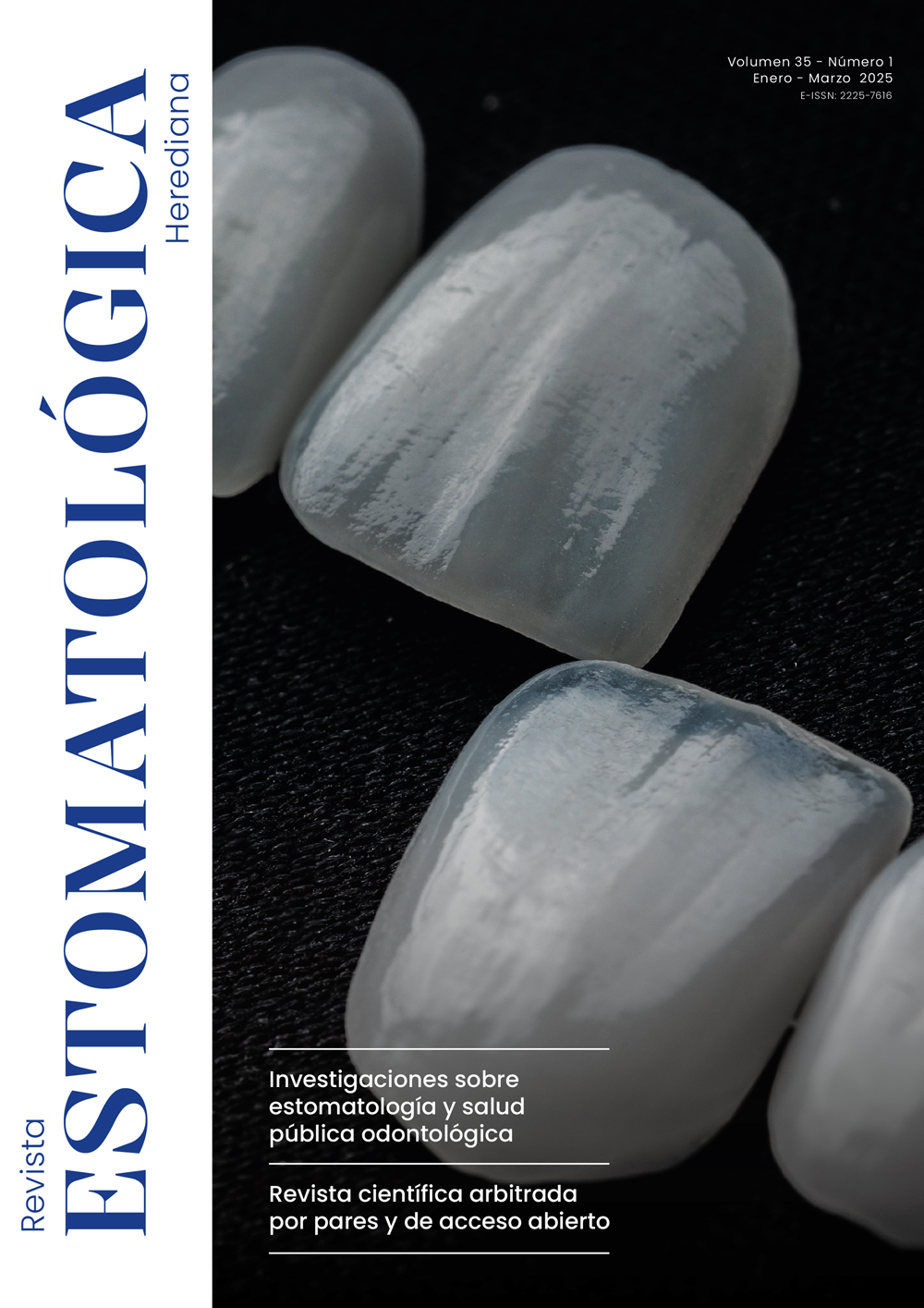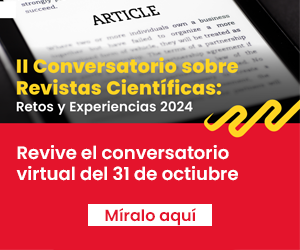Comparação das propriedades mecânicas e da profundidade de cura de resinas compostas bioativas e de bulk-fill
DOI:
https://doi.org/10.20453/reh.v35i1.6247Palavras-chave:
dureza, polimerização, resinas compostasResumo
Objetivo: Comparar as propriedades mecânicas in vitro e a profundidade de cura das resinas bioativas bulk-fill com as resinas compostas bulk-fill. Materiais e Métodos: foi realizado um estudo experimental in vitro com 48 blocos de três tipos de resina. Cada bloco foi carregado com 500 g por 30 segundos e fotopolimerizado com uma unidade VALO® Cordless-Ultradent (1500 mW/cm2) por 4 segundos. A microdureza foi avaliada pelo teste de dureza Vickers, usando um testador de dureza LG® HV-1000 calibrado. Para a análise estatística, foram aplicados o teste t de Student e o teste não paramétrico de Kruskal-Wallis, considerando a significância estatística se p < 0,05. Resultados: A resina bioativa Beautifil® Bulk (BB) apresentou a maior microdureza, com um valor médio de 55,1 VH (p < 0,01), seguida pelas resinas Tetric® N-Ceram Bulk Fill (TNCBF) com 44,9 VH e Tetric® N-Flow Bulk Fill (TNFBF) com 28,8 VH. A resina bulk-fill fluida TNFBF apresentou a maior resistência à compressão, com uma média de 222,4 MPa (p < 0,01), em comparação com 173,5 MPa para a resina fundível TNCBF e 129,7 MPa para a resina fluida BB. Todas as três resinas avaliadas atingiram uma profundidade de cura média homogênea de 4,0 mm (p > 0,05). Conclusões: A resina BB bioativa demonstrou maior microdureza em comparação com as resinas bulk-fill moldáveis e fluidas, enquanto a resina bulk-fill fluida TNFBF apresentou a maior resistência à compressão. Todas as três resinas apresentaram valores semelhantes para a profundidade de cura.
Downloads
Referências
Pereira RA, Araujo PA, Castañeda-Espinosa JC, Mondelli RF. Comparative analysis of the shrinkage stress of composite resins. J Appl Oral Sci [Internet]. 2008; 16(1): 30-34. Disponible en: https://doi.org/10.1590/s1678-77572008000100007
Park J, Chang J, Ferracane J, Lee IB. How should composite be layered to reduce shrinkage stress: incremental or bulk filling? Dent Mater [Internet]. 2008; 24(11): 1501-1505. Disponible en: https://doi.org/10.1016/j.dental.2008.03.013
Leprince JG, Palin WM, Vanacker J, Sabbagh J, Devaux J, Leloup G. Physico-mechanical characteristics of commercially available bulk-fill composites. J Dent [Internet]. 2014; 42(8): 993-1000. Disponible en: https://doi.org/10.1016/j.jdent.2014.05.009
Vianna-de-Pinho MG, Rego GF, Vidal ML, Alonso RC, Schneider LF, Cavalcante LM. Clinical time required and internal adaptation in cavities restored with bulk-fill composites. J Contemp Dent Pract [Internet]. 2017; 18(12): 1107-1111. Disponible en: https://doi.org/10.5005/jp-journals-10024-2184
Strini BS, Marques JF, Pereira R, Sobral-Souza DF, Pecorari VG, Liporoni PC, et al. Comparative evaluation of bulk-fill composite resins: knoop microhardness, diametral tensile strength and degree of conversion. Clin Cosmet Investig Dent [Internet]. 2022; 14: 225-233. Disponible en: https://doi.org/10.2147/ccide.s376195
Abuljadayel R, Mushayt A, Al Mutairi T, Sajini S. Evaluation of bioactive restorative materials’ color stability: effect of immersion media and thermocycling. Cureus [Internet]. 2023; 15(8): e43038. Disponible en: https://doi.org/10.7759/cureus.43038
Tongtaksin A, Leevailoj C. Battery charge affects the stability of light intensity from light-emitting diode light-curing units. Oper Dent [Internet]. 2017; 42(5): 497-504. Disponible en: https://doi.org/10.2341/15-294-l
Spajić J, Prskalo K, Šariri K, Par M, Pandurić V, Demoli N. Dimensional changes of glass ionomers and a giomer during the setting time. Acta Stomatol Croat [Internet]. 2018; 52(4): 298-306. Disponible en: https://doi.org/10.15644/asc52/4/3
Colak H, Ercan E, Hamidi MM. Shear bond strength of bulk-fill and nano-restorative materials to dentin. Eur J Dent [Internet]. 2016; 10(1): 40-45. Disponible en: https://doi.org/10.4103/1305-7456.175697
Mandhalkar R, Paul P, Reche A. Application of nanomaterials in restorative dentistry. Cureus [Internet]. 2023; 15(1): e33779. Disponible en: https://doi.org/10.7759/cureus.33779
Besinis A, De Peralta T, Tredwin CJ, Handy RD. Review of nanomaterials in dentistry: interactions with the oral microenvironment, clinical applications, hazards, and benefits. ACS Nano [Internet]. 2015; 9(3): 2255-2289. Disponible en: https://doi.org/10.1021/nn505015e
Arif W, Rana NF, Saleem I, Tanweer T, Khan MJ, Alshareef SA, et al. Antibacterial activity of dental composite with ciprofloxacin loaded silver nanoparticles. Molecules [Internet]. 2022; 27(21): 7182. Disponible en: https://doi.org/10.3390/molecules27217182
Ahmed B, Hamama HH, Mahmoud SH. Microshear bond strength of bioactive materials to dentin and resin composite. Eur J Dent [Internet]. 2023; 17(3): 917-923. Disponible en: https://doi.org/10.1055/s-0042-1756692
Sauro S, Makeeva I, Faus-Matoses V, Foschi F, Giovarruscio M, Pires PM, et al. Effects of ions-releasing restorative materials on the dentine bonding longevity of modern universal adhesives after load-cycle and prolonged artificial saliva aging. Materials [Internet]. 2019; 12(5): 722. Disponible en: https://doi.org/10.3390/ma12050722
Ebaya MM, Ali AI, Mahmoud SH. Evaluation of marginal adaptation and microleakage of three glass ionomer-based class V restorations: in vitro study. Eur J Dent [Internet]. 2019; 13(4): 599-606. Disponible en: https://doi.org/10.1055/s-0039-3401435
Sajini SI, Alshawi BA, Alharbi LM. Assessment of remineralisation potentials of bioactive dental composite using an in-vitro demineralised dentine model. J Taibah Univ Med Sci [Internet]. 2022; 17(4): 640-647. Disponible en: https://doi.org/10.1016/j.jtumed.2021.12.004
Nagi SM, Moharam LM, Zaazou MH. Effect of resin thickness, and curing time on the micro-hardness of bulk-fill resin composites. J Clin Exp Dent [Internet]. 2015; 7(5): e600-e604. Disponible en: https://doi.org/10.4317/jced.52536
Samuel A, Raju R, Sreejith KB, Kalathil BM, Nenavath D, Chaitra VS. Comparative evaluation of the surface hardness of different esthetic restorative materials: an in vitro study. J Pharm Bioallied Sci [Internet]. 2020; 12(Suppl 1): S124-S128. Disponible en: https://doi.org/10.4103/jpbs.jpbs_40_20
Musavinasab SM, Norouzi Z. Hardness and depth of cure of conventional and bulk-fill composite resins in class II restorations with transparent and metal matrix strips. Front Dent [Internet]. 2023; 20: 20. Disponible en: https://pmc.ncbi.nlm.nih.gov/articles/PMC10493112/
Saati K, Khansari S, Mahdisiar F, Valizadeh S. Evaluation of microhardness of two bulk-fill composite resins compared to a conventional composite resin on surface and in different depths. J Dent [Internet]. 2022; 23(1): 58-64. Disponible en: https://doi.org/10.30476/dentjods.2021.87669.1278
Parasher A, Ginjupalli K, Somayaji K, Kabbinale P. Comparative evaluation of the depth of cure and surface roughness of bulk-fill composites: an in vitro study. Dent Med Probl [Internet]. 2020; 57(1): 39-44. Disponible en: https://doi.org/10.17219/dmp/113003
Publicado
Como Citar
Edição
Seção
Licença
Copyright (c) 2025 Teresa Etelvina Rios Caro, Carlos Manuel Rios _Angulo, Marco Cesar Rios-Caro

Este trabalho está licenciado sob uma licença Creative Commons Attribution 4.0 International License.
Os autores mantêm os direitos autorais e cedem à revista o direito de primeira publicação, sendo o trabalho registrado com a Licença Creative Commons, que permite que terceiros utilizem o que é publicado desde que mencionem a autoria do trabalho, e ao primeiro publicação nesta revista.























